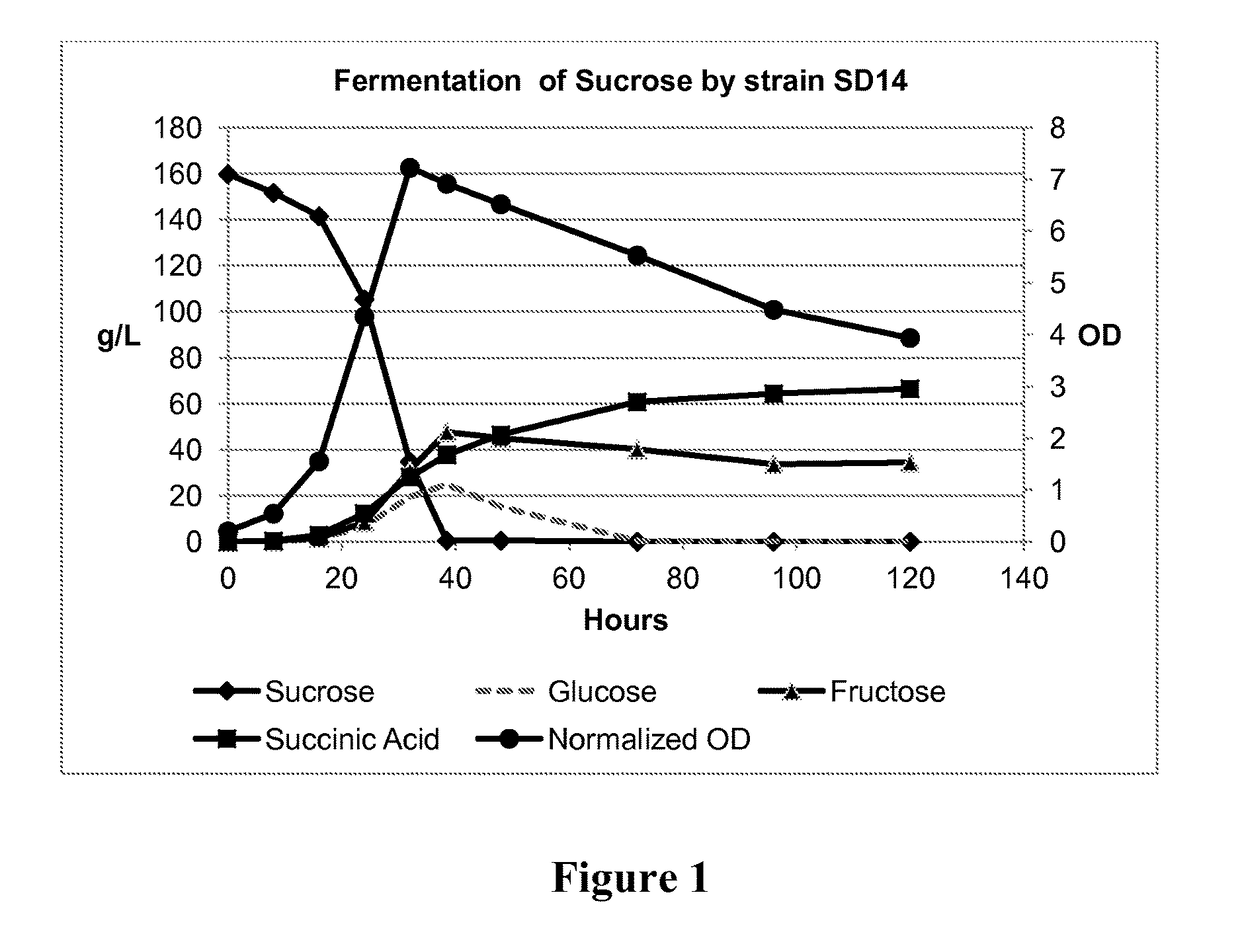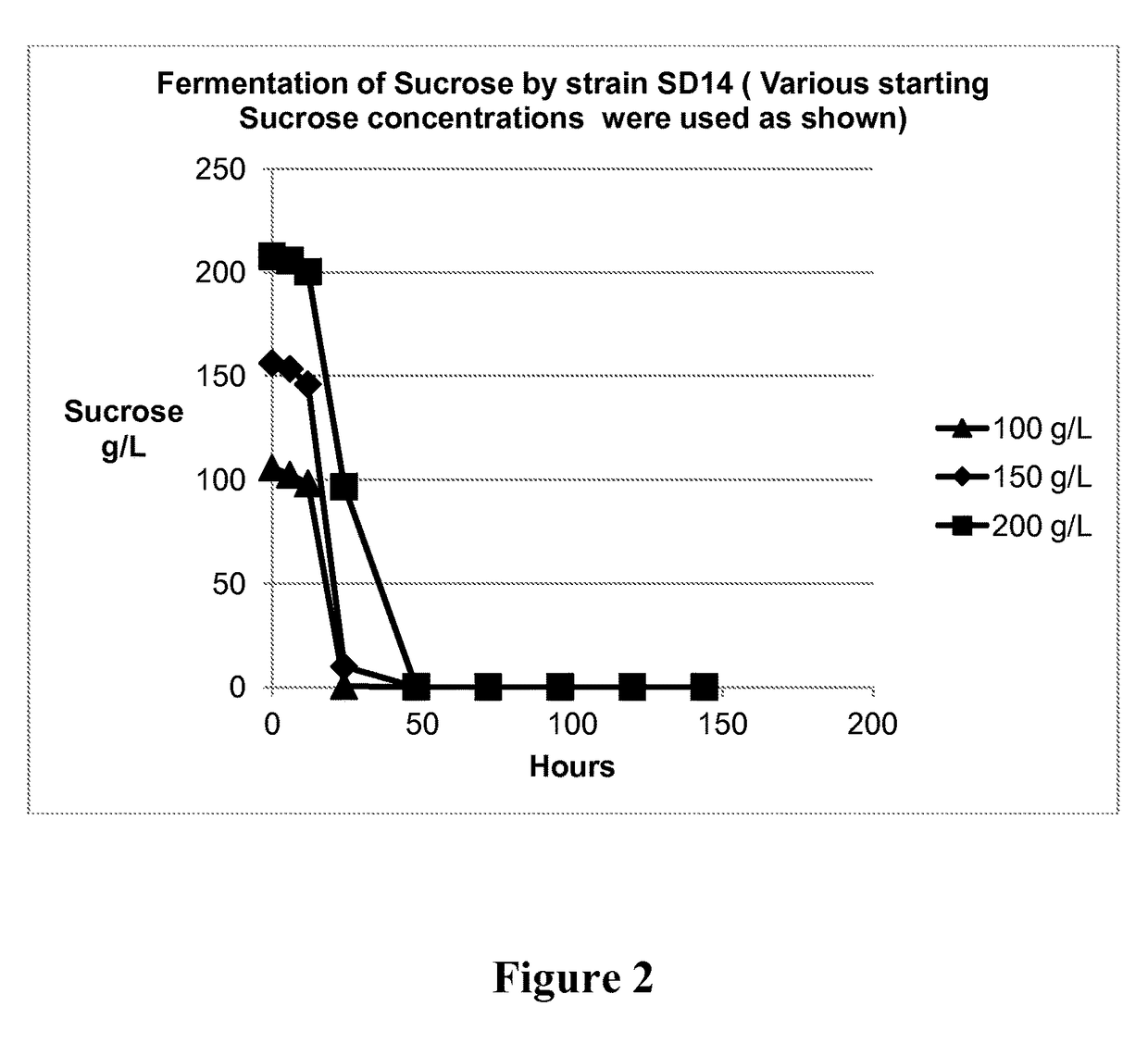Method of producing succinic acid and other chemicals using sucrose-containing feedstock
a technology of sucrose-containing feedstock and succinic acid, which is applied in the direction of transferases, enzymology, bacteria-based processes, etc., can solve the problems of system inability to achieve commercially attractive utilization of sucrose for fermentation using sucrose-containing medium, and achieve the ability to import and metabolize sucrose, improve the yield and productivity of succinic acid, and improve the capacity of biocatalysts
- Summary
- Abstract
- Description
- Claims
- Application Information
AI Technical Summary
Benefits of technology
Problems solved by technology
Method used
Image
Examples
example 1
Construction of SD14, a Derivative of KJ122 that Contains the cscBKA Gene Cluster from E. Coli W
[0090]The cscBKA gene cluster encoding genes for sucrose utilization uptake and utilization, was amplified from the genomic DNA of the W strain of Escherichia coli (ATCC 9637) using polymerase chain reaction. The PCR primers were designed in such a way so that the resulting PCR product contained only the cscB, cscK, and cscA genes from the original csc operon in the W strain and not a functional cscR gene encoding for a repressor protein. In addition to sequences homologous to the csc operon, the primers for PCR amplification included at the 5′ end 50 bases (bp) of sequences that are homologous to the site for integration into the E. coli KJ122 chromosome. The sequences of the PCR primers used in this example are listed in the Table 1. The target site for integration is 291 bp upstream from the rrnC gene. This site does not code for any known genes thus minimizing the possibility of disru...
example 2
Analysis of Growth and Sucrose Utilization in the Recombinant Stain SD14 in a 7 Liter Fermentor
[0094]The SD14 strain was grown in minimal medium supplemented with 10% sucrose. A stock solution containing both ammonium hydroxide and ammonium bicarbonate (7 N NH4OH and 3M NH4HCO3) was used to neutralize succinic acid produced in the fermentors at 39° C. The starting volume of 3 liters contained potassium phosphate monobasic (18 mM) magnesium sulfate (2 mM), betaine (1.33 mM), trace elements (Jantama et al., 2008a, b), Antifoam 204 (8 ppm) and sucrose batched at 98 g / l. pH was adjusted initially to pH 7.0 and thereafter was maintained at pH 6.5 by addition of the ammonium hydroxide / ammonium bicarbonate solution described above. Air was delivered at 5 ml / minute. The 150 ml inoculum was grown aerobically and contained a minimal medium with 2% sucrose and supplemented with 0.1 mM calcium chloride.
[0095]For comparison, KJ122 was fermented in the same medium with the same neutralization sol...
example 3
Cloning and Expression of a Sucrose Phosphorylase in SD14
[0097]The sucrose phosphorylase gene from Leuconostoc mesenteroides strain DSM 20193 (Goedl et al., 2007) is cloned by PCR amplification using primers BY107 and BY108 (see Table 1) and genomic DNA as a template. The resulting 1594 bp PCR product is purified on a Quiagen QIAquick PCR purification column, cleaved with XbaI and BamHI restriction enzymes (New England Biolabs), and purified by agarose gel electrophoresis. The resulting fragment is ligated into the XbaI to BamHI backbone of pOM324 (US Patent Application 2009 / 0311756) to give plasmid pRY801, which places the sucrose phosphorylase gene under the control of a strong constitutive promoter. The promoter-sucrose phosphorylase gene-terminator cassette is excised from pRY801 by cutting with XhoI and BamHI, and the sticky ends of the resulting cassette are made blunt with the Quick Blunting Kit (New England Biolabs) and the blunted fragment is ligated into pMH17F (SEQ ID NO....
PUM
| Property | Measurement | Unit |
|---|---|---|
| volume | aaaaa | aaaaa |
| volume | aaaaa | aaaaa |
| volume | aaaaa | aaaaa |
Abstract
Description
Claims
Application Information
 Login to View More
Login to View More - R&D
- Intellectual Property
- Life Sciences
- Materials
- Tech Scout
- Unparalleled Data Quality
- Higher Quality Content
- 60% Fewer Hallucinations
Browse by: Latest US Patents, China's latest patents, Technical Efficacy Thesaurus, Application Domain, Technology Topic, Popular Technical Reports.
© 2025 PatSnap. All rights reserved.Legal|Privacy policy|Modern Slavery Act Transparency Statement|Sitemap|About US| Contact US: help@patsnap.com



